May 18, 2007
Air Date: May 18, 2007
FULL SHOW
SEGMENTS
Bright Ideas on Energy Efficiency
/ Jeff YoungView the page for this story
How many light bulbs does it take to change U.S. energy consumption? An efficiency bill in Congress could include a plan to phase out the incandescent light bulb. It's one of the energy saving proposals that have efficiency advocates wondering if the United States is finally seeing the light on conservation. Living on Earth's Jeff Young reports from Washington. (06:00)
New-Old Nukes
View the page for this story
The Browns Ferry nuclear power plant in Alabama has received the green light to start generating power again. The nuclear plant had a near-meltdown in 1975 and was eventually shut down. Host Bruce Gellerman talks with Peter Gwynne who covered the Browns Ferry accident for Newsweek in 1975. He also speaks with Tennessee Valley Authority spokesman Craig Beasley to find out what’s been done to improve safety at the facility today. (06:00)
Climate Control
View the page for this story
Reducing our greenhouse gas emissions may not be sufficient to curb global warming, so some scientists are proposing large-scale geo-engineering projects to pick up the slack. Bill Gail writes about nine ways to cool the planet in this month's issue of IEEE Spectrum magazine. He tells host Bruce Gellerman about these ideas and about a new concept called "climate management." (06:15)
Falcon Addiction
/ Nancy MullaneView the page for this story
Peregrine falcons are no longer endangered; in fact, they're thriving. They seem to prefer nesting in downtown cities, and in San Jose, California that's spawned a small movement of people who follow the birds' love lives and the antics of their fuzzy-headed hatchlings on webcams. Nancy Mullane reports. (06:45)
Birding...with an iPod?
/ Noah StryckerView the page for this story
Birder Noah Strycker says modern techonology can be used - with care - to assist birders in the field. (03:10)
Hunting for the Next Pandemic
View the page for this story
Many of the major human infectious diseases - such as HIV, the plague and cholera - got their start as diseases in animals. Understanding how these microbes and viruses make the leap from animals to humans could give scientists a leg up in finding the next big pandemic before it hits. Nathan Wolfe, an epidemiologist from UCLA, talks to host Bruce Gellerman about hunting for viruses in the jungles of Cameroon. (09:00)
Loss Lingers In New Orleans
/ Ingrid LobetView the page for this story
The psychological cost of losing one’s neighbors and the connections that comprise a home, is one native New Orleanean Rodney Dejoie has had to pay. Living on Earth’s Ingrid Lobet met with Mr. Dejoie in his Ninth Ward neighborhood and produced this portrait. (05:45)
This week's EarthEar selection
listen /
download
This group of elephants in Lampang Province, Thailand makes some noise using confiscated tools from illegal loggers.
Show Credits and Funders
Show Transcript
HOST: Bruce Gellerman
GUEST: Craig Beasley, Rodney Dejoie, Peter Gwynne, Bill Gail, Nathan Wolfe
REPORTER: Ingrid Lobet, Nancy Mullane, Jeff Young
COMMENTARY: Noah Strycker
[THEME]
GELLERMAN: From Public Radio International - this is Living on Earth.
[THEME]
GELLERMAN: I’m Bruce Gellerman. Six years after Vice President Cheney dismissed it as merely a personal virtue, conservation is back with a vengeance:
CALLAHAN: I think that folks are finally getting it. That we can use energy efficiency as the cornerstone of sustainable energy future policy. I mean that has to be there.
GELLERMAN: Also, scientists consider deliberately changing the climate to cool things down.
And singing the post Katrina blues one New Orleanean’s lament.
DEJOIE: I didn’t even go to the parades this year to enjoy Mardi Gras, I mean I was so busy trying to piece back my life. Maybe I’m suffering from some sort of depression or something, I don’t know, but I haven’t been to a psychiatrist or any of that kinda stuff, I just go on to get back to normal.
GELLERMAN: These stories and more this week on Living on Earth. Stick around!
[MUSIC: Boards of Canada “Zoetrope” from ‘In A Beautiful Place Out in the Country’ (Warp Records – 2000)]
[NPR NEWSCAST]
ANNOUNCER: Support for Living on Earth comes from the National Science Foundation and Stonyfield Farm.
Bright Ideas on Energy Efficiency

(Courtesy of www.Utah.gov)
GELLERMAN: From the Jennifer and Ted Stanley Studios in Somerville, Massachusetts - this is Living on Earth. I’m Bruce Gellerman.
Six years ago, when Vice President Dick Cheney tried to solve the energy problem he came down on the production side of the equation more oil and more gas. As for conserving energy, Cheney dismissed that as, “a sign of personal virtue” a nice gesture, perhaps but no basis for national policy. Well, times, prices and attitudes even among some in the Bush administration have changed. As Living on Earth’s Jeff Young reports officials are now calling for cuts in the consumption of oil and gas and there’s talk in Washington of new efficiency standards for autos, appliances even light bulbs.
YOUNG: We know all the jokes: How many so and so’s does it take to change a light bulb. Well, turns out we’ve had the question backwards: it should be How many
light bulbs does it take to change us and our energy wasting economy?
CALLAHAN: If every home in America switched out just one incandescent
bulb with a compact fluorescent it would be the equivalent in CO2 savings of
a million cars off the road for a year. Just one light bulb!
YOUNG: That’s Kateri Callahan at the Washington think tank Alliance to Save Energy getting excited about something that most consider pretty dull: energy efficiency. And she’s right: the numbers are exciting. If we changed all four billion of the country’s sockets to more efficient lighting it could save 10 billion dollars in electricity costs a year. And it would eliminate the need for 50 coal-fired power plants. That’s why Callahan’s alliance is part of a negotiating team with lighting industry leaders Phillips, GE, and Sylvania to craft federal law that would make the switch.
CALLAHAN: We’re working hard to try to develop technology neutral standard that’ll get most inefficient, that cheap, 25 cent light bulb off the market.

(Courtesy of www.Utah.gov)
YOUNG: All sides agree in principle that it’s time for lighting standards to change. But there are some sticking points: chiefly, which products would be affected and how many years it would take. Australia’s already announced a phase-out of incandescent bulbs in five years and Canada’s working on a similar proposal. California’s moving toward doing it. If other states follow, the industry could face a hodge podge of different standards. Richard Upton of the American Lighting Association says that motivates industry to seek a national law.
UPTON: Because we’re talking about interstate commerce and to have 50 different kinds of ideas and regulations and labeling requirements all of a sudden becomes something that business and industry can’t respond to very well; and that’s more confusion for consumers. So working to get a federal bill makes the greatest sense to me.
YOUNG: Upton says some consumers are already buying more efficient lighting, mostly the compact fluorescents known as CFL’s. But Noah Horowitz of the Natural Resources Defense Council says most people won’t buy them as long as the cheaper but wasteful bulb is on the shelf.
HOROWITZ: People just look at first cost and they’re overlooking a very critical thing. That four pack of CFL’s will save you $100 over the life of the bulbs and in addition they last ten times longer. So about 90% of sockets still have incandescent in this country and we’re probably going to require a standard to help shift that.
YOUNG: The light bulb sheds light on larger issues with efficiency: the vast potential for energy savings and the vexing problems in achieving them.
PRINDLE: Oh yeah, energy efficiency is the invisible man of energy policy.
YOUNG: That’s Bill Prindle at the American council for an energy efficient economy. Prindle says the country’s staring at a three-headed hydra of energy threats: national security, high prices and climate change. That’s sparked interest in cleaner sources. But Prindle says even the most optimistic outlook for renewable energy barely keeps pace with our growing energy appetite.
PRINDLE: You know, we’ve got to have more moderate demand growth if any of our great ideas for clean energy, be it solar, wind, biomass—any of those energy sources we’re gonna have a hard time keeping up with demand if we don’t get aggressive on efficiency.
YOUNG: Prindle says one of the best tools is something called the energy efficiency resource standard. It requires utilities to wring waste from energy production and reduce consumer demand through incentives for more efficient appliances, heating and the like. Several states have adopted it. He’d like to see the energy bill that the US Senate’s working on include one, too. Senate energy chair Jeff Bingaman says it’s the direction the country should be moving but probably works best at the state level.
BINGAMAN: Well, I think frankly there are some complications in it when we start trying to legislate it nationally. I think that what we’re probably going to end up with is some things to encourage and incentivize more states to do this.
YOUNG: Bingaman’s bill includes new standards and appliances that could bring big energy savings. And if the light negotiators reach agreement in time he’ll make phasing out the incandescent bulb part of the bill, too. Another bill cooking in Congress could raise fuel efficiency for autos for the first time in decades. And the National Academy of Sciences just issued a statement calling on the US to push energy efficiency at the upcoming G8 summit of economic world powers as a way to combat climate change. Add those up and you understand why Kateri Callahan at the alliance to save energy is so excited.
CALLAHAN: I think that folks are finally getting it; that we can use energy efficiency as the cornerstone of sustainable energy future policy. I mean that has to be there.
YOUNG: The US, which consumes more energy per person than any other country, could finally be seeing the light on conservation.
For Living on Earth, I’m Jeff Young in Washington.
Related links:
- Alliance to Save Energy on lighting
- Philips Lighting on energy saving lights
- National Academy of Sciences statement on efficiency
- Senate Energy Committee's efficiency bill
- LOE interview on mercury & compact fluorescent bulbs (3/9/07)
New-Old Nukes
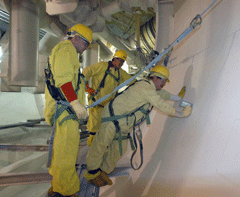
TVA workers measure the thickness of paint on the unit 1 reactor safety system. (Courtesy of Tennessee Valley Authority)
GELLERMAN: The flame from a candle is supposed to shed light on a subject and in the case of the Browns Ferry Nuclear Power Plant in Alabama it sure did that and a lot more. On March 22, 1975 a single candle nearly burned one of the reactors at Browns Ferry to the ground and exposed just how unsafe the nation’s nuclear power industry was at the time. The plant actually continued operating for another ten years before it was shut down in 1985. But now the ill-fated reactor is once again about to go nuclear and begin generating electricity.
Peter Gwynne was the science editor for Newsweek back in 1975 and wrote about the Browns Ferry reactor fire. Hi Peter- Thanks for joining us.
GWYNNE: Thank you. Good to be with you.
GELLERMAN: Well take us back to that fateful day March 22, 1975. It literally started with a candle.
GWYNNE: It did and a couple of the technicians were in one of the corridors using a candle to sniff out air leaks which was the normal way of doing things at the time. They found a leak in an area where a lot of cables were going into the control room of the plant and they decided to repair it with polyurethane foam, which was again the standard way of doing things.
GELLERMAN: Yeah, but the foam, it turns out, wasn’t fire proof.
GWYNNE: Well, when they tested two things happened. First they realized that they hadn’t sealed up the leak. And second the leak that was there sucked in the flame and set the polyurethane on fire. And then the fire really took off despite all their efforts to control it.
GELLERMAN: And it was right near the control room.
GWYNNE: It was and smoke filled the control room pretty quickly.
GELLERMAN: But this is sort of like falling down a flight of steps. Everything from then on started going wrong.
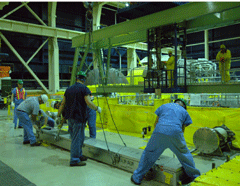
Workers receive new fuel for reactor 1. (Courtesy of Tennessee Valley Authority)
GELLERMAN: They had to scramble the reactor. They shut it down using the last backup system they had.
GWYNNE: They shut down the reactor, um, even so it continued to heat up. But finally they did manage to close it down and after seven hours the fire went out.
GELLERMAN: It’s kind of weird, using a candle to inspect a billion dollar nuclear reactor.
GWYNNE: Well, that wasn’t the only weird thing, Bruce. Um, they found later that their technicians had not been trained in safety procedures. Ah, they had not tested the polyurethane foam just to check whether or not it was flammable. And a whole series of safety issues, of safety checks, had simply not been performed by the authorities at Brown’s Ferry.
GELLERMAN: What was the mood of the country back then in 1975 to nuclear power. There were 56 reactors operating.
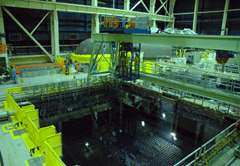
The fuel storage pool for reactor 1. (Courtesy of Tennessee Valley Authority)
GELLERMAN: Peter, thank you very much.
GWYNNE: Thank you, Bruce.
GELLERMAN: Former Newsweek science editor Peter Gwynne wrote about the accident at unit one of the Browns Ferry Nuclear power plant back in 1975. All three of the reactors at the plant continued to operate for another decade before they were finally taken out of service. Units two and three which weren’t affected by the fire went back on line in the 1990s and now, more than three decades after the near disaster, there are plans to bring unit one back online.
The Tennessee Valley Authority owns the Brown’s Ferry plant. Craig Beasley is a spokesman. Craig, thanks for joining me.
BEASLEY: You’re welcome.
GELLERMAN: So, what have you done to improve safety at reactor one?
BEASLEY: Well we have spent a lot of time over the last 20 years working to make safe and reliable power to the people in the Tennessee Valley. You know, when we brought the units off line in 1985 we did a tremendous amount of work to revamp not only Brown’s Ferry but our nuclear program. And since then the units have come back and operated very well, very safely, very reliably to provide power.
GELLERMAN: You’ve also spent a lot of money. What 1.8 billion dollars to bring this reactor back online?
BEASLEY: That’s correct 1.8 billion dollars but what we’re bringing back is probably the newest old plant in the nation. We’ve done a lot of work to ensure that the hardware that we have at the plant is not only current but that it’s in good condition and that we have the people and the programs and the processes in place that are going to make sure that we operate this unit safely and reliably.
GELLERMAN: Wouldn’t it be cheaper to just build a new one from scratch?

TVA workers measure the thickness of paint on the unit 1 reactor safety system. (Courtesy of Tennessee Valley Authority)
BEASLEY: You know when TVA, faced with the growing power demands in the area about five years ago, we looked not only at new generation but you know purchase power, the cost of other fuels like fossil and gas. And we looked at nuclear power and this was the most, the best business decision that we could make; financially, operationally, and environmentally for the area and for us.
GELLERMAN: Any plans to use ah candle tech to check for air leaks in the future?
BEASLEY: (laughs) You know the history of nuclear power is we have a lot of operating experience behind us now. You know you’re talking something 30 years in the past. We’ve had 30 years of operational experience and the industry itself has proved to be safe and reliable. If you look at Browns Ferry now we certainly have, you know, a reactor that’s been there a long time but we have a lot of digital and state of the art instrumentation in the controls and the way we operate these plants now, maintain these plants now is certainly state of the art.
GELLERMAN: Craig Beasley is a spokesman for the Browns Ferry nuclear power plant in Alabama. Mr. Beasley, thank you very much.
BEASLEY: You’re very welcome.
[MUSIC: Pure “La Vaca” from ‘Momentos Perdidos (Lost Moments)’ (Elefant Records – 2004)
Related links:
- The Nuclear Regulatory Commission gave the final OK to put the Browns Ferry Plant back online.
- The Tennessee Valley Authority
- To read a fact sheet on Browns Ferry click here.
- To read about TVA's Nuclear Program click here.
GELLERMAN: Coming up deliberately changing the climate to reverse global warming. That’s just ahead on Living on Earth.
[MUSIC: Magnetaphone “.22 Calibre Family” from ‘Mind Expansion Compilation’ (Mind Expansion - 2006)]
Climate Control
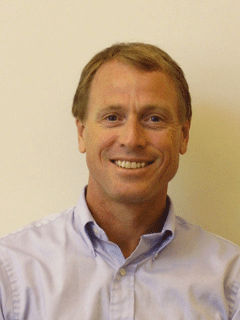
Bill Gail (Courtesy of Bill Gail)
GELLERMAN: It’s Living on Earth. I’m Bruce Gellerman. Mark Twain once famously quipped, "everyone talks about the weather, but no one ever does anything about it."
Well, that may no longer be true. Faced with the potentially dire consequences of climate change, some scientists are now openly discussing the possibility of managing…or geoengineering the climate. The idea is to have a “Plan B” a back up plan just in case reducing greenhouse gases isn’t enough to prevent runaway global warming. Bill Gail has written about some possible “plan B’s” in an article entitled “Climate Control: Nine ways to cool the planet.”
It appears in the latest issue of the IEEE Spectrum magazine. Bill Gail is the Director of Strategic Development at Microsoft’s Virtual Earth. Bill, welcome to Living on Earth.
GAIL: Thank you, Bruce
GELLERMAN: So, it seems to me, Bill, that, ah, you know, since the Industrial Era we’ve been running sort of a giant unintentional global climate experiment. What I hear you say in this article is that we need an intentional intervention, an intentional experiment in the planet’s climate.
GAIL: Well, I think we mistakenly believe that climate change is a one-time problem with a one-time solution. In fact humans have been influencing climate for millennia. And within the last, perhaps, century we’ve acquired the ability to really influence climate on a global basis within the time frame of a human life. So what I’m suggesting is that that ability is going to be with us from now on. And we have a choice. We can either choose to use that inadvertently or blindly or we can choose to manage how that influence occurs.
GELLERMAN: Some of the proposed ideas in your article are not so farfetched actually. You’ve got reforestation, sequestration. But others are really far out, kind of whacky sci-fi stuff like space shields and space dust?

Bill Gail (Courtesy of Bill Gail)
GAIL: Well that’s right there’s really a range of technological approaches to addressing climate change. Some of them are perhaps more accepted, more mature than others. But some are indeed much further out; ideas that are perhaps just early ideas. Just as Jules Verne’s early ideas about space travel ultimately led to the ability to get to the moon.
GELLERMAN: Well, tell me about space dust.
GAIL: Well, it’s an idea for scattering dust in space that would reflect some of the sunlight and reduce the amount of sunlight that reaches the earth. Alternately you could scatter similar dust, perhaps sulfide particles, in the stratosphere. That’s ah, in some ways a more viable approach because it would last longer in the stratosphere and be more effective.
GELLERMAN: And space shields?
GAIL: Space shields, uh, there’s several ways to do that. But the general idea is that you put up some sort of reflective or refractive object in space that scatters sunlight before it reaches the earth.
GELLERMAN: I know that there’s one proposal here that’s more than just a proposal. That’s the one for iron dust. What’s that about?
GAIL: Well, the idea is that plankton growth depends on nutrients in the ocean. Plankton take up carbon dioxide as they grow and once they die those plankton sink to the bottom of the ocean and sequester that carbon dioxide. So the idea is that by adding nutrients to the ocean you enhance the plankton growth and therefore increase the carbon uptake.
GELLERMAN: There’s a group off the coast of Ecuador that’s doing just that right now.
GAIL: That’s right. There’s some groups that see this as a commercial opportunity with need for solutions to climate change. And they’re going after this quite aggressively in terms of testing out the approach, seeing whether it’s economically viable.
GELLERMAN: Well, what happens if there’s an oops? You know, an unexpected consequence and it triggers a catastrophe, they get it wrong?
GAIL: That’s absolutely the biggest concern. Climate change is a huge, huge problem. And our ability to deal with it is going to require that we look at very, very difficult and challenging solutions, many of which have risks associated with them. And as we develop the ability to, um, pursue some of these solutions we’re going to also develop the ability to manage those risks quite carefully.
GELLERMAN: But who decides to take those risks? You know we decide that we need more rainfall in the United States which means there’s drought in Africa.
GAIL: This is an international problem and it affects all countries. Ah, we need to develop the international mechanisms to allow us to answer those questions.
GELLERMAN: But right now don’t we have an international treaty that prevents science from going in and changing the weather? You can’t use weather as a weapon.
GAIL: That’s right, and of course any new technology runs the risk of being used as a weapon. I think that we have to face that and we have to actively pursue the opportunities so that it is used for good rather than bad. If we decide to just do nothing it’s certainly possible that some nation will grasp the opportunity and use that technology for bad.
GELLERMAN: But couldn’t some, you know, climate terrorist group use this technology then?
GAIL: Well, I think refraining from understanding how this technology could be used doesn’t prevent people from using it in the wrong way. They will think to do that whether or not we’re trying to use it for good.
GELLERMAN: So it doesn’t send any trepidation through your spine when you think about climate management or mismanagement?
GAIL: Oh, it sure does. I think we’re into a new realm here. Where we’re exploring some very new things. But I think it’s something that we’ve backed ourselves into where we need to look at all possible solutions. And no solution is going to be easy. No solution is going to be without risk. This is just one more thing that we need to be looking at and we shouldn’t pull it off the table before we understand whether it is a viable solution or not.
GELLERMAN: Well, Bill Gail, thank you very much. I appreciate your time.
GAIL: Thank you Bruce.
GELLERMAN: Bill Gail is Director of Strategic Development at Microsoft’s Virtual Earth & serves on the U.S. National Research Council’s Earth Science Group. His article “Climate Control: Nine ways to cool the planet” appears in the latest issue of the IEEE Spectrum magazine. You can fink a link to the article at loe dot org.
[MUSIC Strike The Colours & Rody Gorman “Message In A Bottle” from ‘Ballads Of The Book’ (Chemikal Underground - 2007)]
Related link:
"Climate Control" in IEEE Spectrum
Falcon Addiction
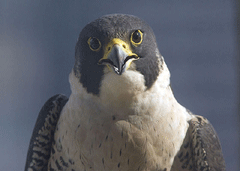
This front view of Gracie shows the protrusion on the upper mandible (tomial tooth) just behind the curve of the beak, and the matching depression in the lower mandible- two features that are used to aid in severing the spinal cord after prey has been caught. (Copyright © 2006/2007 Glenn Nevill)
GELLERMAN: This week we have two reports on the frontiers of finding our fine-feathered friends. In a few minutes, I pod therefore I bird. But first, we head for the urban byways of the San Francisco bay area. That’s where a once-endangered bird is now making a comeback from the brink. In 1970, there were only two known nesting pairs of Peregrine falcons in all of California and none east of the Mississippi. Peregrines are known for their breathtaking dives, plunging to earth at over 200 miles an hour, but the pesticide DDT nearly decimated the falcons.
Thirty years on people have helped Peregrines make a remarkable recovery. And now many of the birds are nesting right in the middle of American cities. The drama of their recovery is due in part to the development of new urban habitats and technologies which are turning some city folk into the falcon obsessed. Nancy Mullane reports.
[CITY SOUNDS OF SAN JOSE CITY HALL]
LOEWEN: If you turn and look, this is the south side of the building, and at the top of it, you see this white box and that’s the nest box.
MULLANE: Evet Loewen is Chief Deputy City Attorney for San Jose. But instead of sitting in her office chair looking at briefs, she’s standing on the ground outside City Hall looking up. It wasn’t always like this. About eighteen months ago Jose and Clara, a pair of peregrine falcons set up housekeeping on a ledge on the side of the city hall building. Now, Loewen says, she’s not the only one transfixed by the raptors and their three new baby chicks.
LOEWEN: I have yet to run into a city department where people weren’t talking about the birds. They call me up and leave me messages on my phone. They talk to the city attorney and let him know and I know the mayor is very interested in the birds.
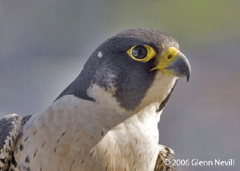
This photo of Gracie was shot on the day that the first egg was discovered. It shows a white feather behind her right eye that has been used to help identify her from a distance through spotting scopes. (Copyright © 2006/2007 Glenn Nevill)
LOEWEN: There’s a group of us that are very dedicated and will want to make sure those birds are safe. It’s something you know I think there will be many, many, many people out when they think those birds will take their first flight.
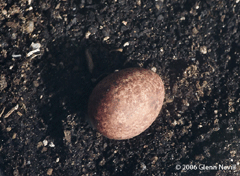
This first falcon egg of the season (photo taken through window) was found in planter on the 30th floor balcony of 201
Mission, San Francisco. Discovery of the egg in this unexpected location led to the closing of the balcony for security and a flurry of activity to get permission to move the web camera to the new site. (Copyright © 2006/2007 Glenn Nevill)
MULLANE: One way Loewen and the others track the fledglings daily developments, while they’re stuck at their desks, is through a 24-7 webcam. It was set up at the nest by the UC Santa Cruz Predatory Bird Research Group so people could watch the birds live, minute by minute. Sometimes demand overwhelms the system.
STAVELEY: It can crash, ah, it has crashed (laughs).
MULLANE: Claire Staveley manages the web-cam for the Research Group. She says the falcon cam is getting more than 700,000 hits a week, from as far away as Iraq.
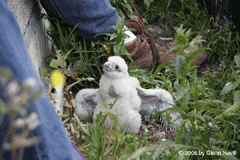
High atop 201 Mission on the 30th floor balcony, a young eyas is about to be banded by Brian Latta.
(Copyright © 2006/2007 Glenn Nevill)
MULLANE: Now that the raptor is breeding successfully on its own, Researcher Glenn Stewart says the webcam is the public’s window onto the world of this exceptional bird.
STEWART: For thirty years, we’ve been looking at these birds through binoculars and spotting scopes and now for the first time anybody in the world with an internet connection can watch the intimate family life of a peregrine falcon and just people are thrilled by it.
MULLANE: Part of the thrill, Stewart says, is that web-cam wild life is unedited.
STEWART: They see exactly what happens. They see when the eggs don’t hatch or when they hatch and the babies die and so that’s a little bit hard sometimes, but people come to me and say I didn’t know I was a bird watcher until I saw these birds.
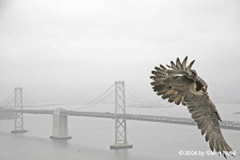
During the banding of the eyas, the mother falcon (Gracie) made multiple passes to try to drive off the biologists. (Copyright © 2006/2007 Glenn Nevill)
[SOUND OF STUDENTS ENTERING ALL-PURPOSE ROOM]
MULLANE: Stewart makes dozens of visits each year to nearby schools. He says it’s one way of guaranteeing the future protection of the species.
On a recent visit to a middle school, Stewart brought along a six-year-old falcon named Curtis.
STEWART: Actually…don’t go behind…they don’t like to feel surrounded.
[SQUAWKING]
MULLANE: Stewart moves in and puts on a thick leather glove. He holds his arm out for Curtis. The student’s eyes are wide. Curtis carefully steps onto the glove. Then in one smooth movement, Stewart slips a custom-made leather hood over Curtis’s eyes for the half-hour trip back to the Research center.
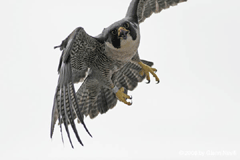
This shot of Gracie was taken with a 400 mm lens in the vain attempt at reading her band numbers. The number (1807-02648) was finally read through the window after banding of the eyas was completed. Using their database, the biologists were able to determine that she had been banded as a year old bird in the Marin Headlands on November 28, 2001 thus making her about 6 years old. (Copyright © 2006/2007 Glenn Nevill)
[DOWNTOWN CAR SOUNDS]
MULLANE: While the San Jose group watches and waits for their three fledglings to fly in San Francisco, another group of falconistas keeps tabs on a couple they know as George and Gracie. Cheryl Wolfcale says she was bit with the falcon bug after birders came into the law firm where she works.
WOLFCALE: The bird people came in, wanted to look out our windows and I thought, this would be interesting to explore, find out what’s going on and I’ve been wandering the streets at night, coming out on the weekends and (laughs) more nights than I care to admit to.
[PIER SOUNDS]
MULLANE: As she talks, her eyes scan the sides of buildings. Then, like people bar-hopping, Wolfcale and her friends, Kanit Katrell and Glenn Nevill soon leave the downtown streets and head for next stop, the end of a pier on the bay. They set up two long-range scopes and focus binoculars and cameras hoping for a sighting.
KATRELL: We do have a relationship. Cheryl and I talk to her, we talk to Gracie (laughs) and George.

This front view of Gracie shows the protrusion on the upper mandible (tomial tooth) just behind the curve of the beak, and the matching depression in the lower mandible- two features that are used to aid in severing the spinal cord after prey has been caught. (Copyright © 2006/2007 Glenn Nevill)
NEVILL: But we are also fully aware they could care less what we think.
MULLANE: As the sun starts to set the group begins to talk about packing up and going home, but it turns out that’s just talk.
SAN FRANCISCO GROUP: They’re still here and there’s always next year. Ok, there’s one flying going back to the east there it is flying, oh yes it landed right on the scaffolding.
MULLANE: This kind of love may be one-sided but it may well keep the Peregrine falcons alive and well. For Living on Earth, I’m Nancy Mullane.
SAN FRANCISCO GROUP: Now Gracie’s hoping back there. They’re back in the corner in the dark now. Love Shack we found the love shack. (laughter) They disappear at night they give us the slip. Like 7:30 8 o’clock so Cheryl says they’re off to their love shack can’t see them.
[MUSIC: The B-52’s “Love Shack” from ‘Cosmic Thing’ (Reprise Records - 1989)]
GELLERMAN: You can find a link to the falcon cam, at Loe dot o-r-g. WE don’t egg-actly know but estimated hatch date for the San Jose chicks is June 15th.
[MUSIC: The B-52’s “Love Shack” from ‘Cosmic Thing’ (Reprise Records - 1989)]
Related links:
- San Cruz Predatory Bird Research Group (includes a live web cam)
- San Jose Peregrine Falcon Association
- Glenn Neville's website with falcon photographs
Birding...with an iPod?
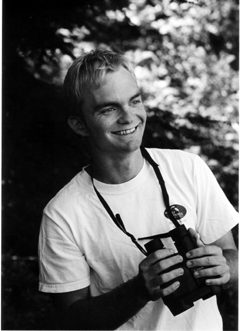
Noah Strycker (Photo: Bob Keefer)
GELLERMAN: Ok birders, this bud’s for you. White ear buds that is. You know those tell-tale signs of musical isolation that cut people off from the rest of the world? Well, what if the iPod could instead connect you with the great outdoors? Enter commentator Noah Strycker who has repurposed the iPod for i-birding.
STRYCKER: The little gizmo more than proved its worth one spring morning in an impressive demonstration in a patch of Ponderosa Pine forest. I was on a mission for a sighting and after I decided which songbird I wanted to see.
(IPOD DIALING AND SPARROW CALL)
I dialed up the pre-programmed call on my iPod, broadcast the song through an external speaker, and—bada bing!—there it was, a male Chipping Sparrow, hormones pumping, singing madly from the branch in front of me. Like magic. Dial-A-Bird.
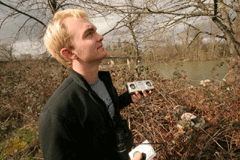
Noah Strycker dials up his ipod in the field. (Photo: Bob Keefer)
On another occasion, it was near midnight, and I was standing alone in the inky blackness of an Oregon night. A creepy silence blanketed the scene. I had a tip that Barred Owls were in the area, and I wanted to see one. In the past ten minutes, however, nothing had stirred. It was time for Plan “B”.
I dialed up “Barred Owl” on my trusty iPod and played the recording, a raucous Whoo-Cooks-For-You-All, twice.
[IPOD DIALING AND BARRED OWL CALL]
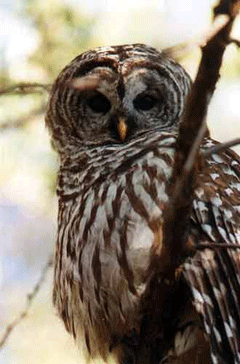
The barred owl. (Photo: Noah Strycker)
As a tool for modern birders, the iPod is both handy and reasonably inexpensive. It goes with your state-of-the-art binoculars, spotting scope, digital camera, long camera lenses, cellphone with pre-programmed Rare Bird Alert numbers, tuna sandwiches, and B-R-D, B-O-Y license plates. You can get everything but the plates—sorry, those are mine!
Don’t expect an iPod to make you an elite birder. It can’t replace actual knowledge and experience, and it takes a fair amount of time to set up. On outings, I follow common sense with my iPod, trying to be considerate and unobtrusive of birds’ activities, especially in heavily birded areas, and never using playbacks for attracting any species that is threatened, endangered, or of special concern.

Noah Strycker (Photo: Bob Keefer)
As a birding tool, the iPod can be a great way to reach out to the world around us. And that’s cool not just for the iPod Generation, but for any generation.
[MUSIC: Music: Bunnyhug “Destruction” from ‘Momentos Perdidos (Lost Moments)’ (Elefant Records – 2004)]
GELLERMAN: Noah Strycker is the Associate Editor of Birding magazine, and was named Young Birder of the Year in 2004 by the American Birding Association. His work is featured in the new book Good Birders Don't Wear White: 50 Tips from North America’s Top Birders.
Related link:
Noah Strycker's website
GELLERMAN: You can hear our program anytime or get a podcast at LOE dot org. That's LOE dot O-R-G. And you can always chirp in with your comments at comments @ l-o-e dot org. Once again, comments @ l-o-e dot O-R-G. Our carrier pigeon address is 20 Holland Street, Somerville, Massachusetts, 02144. Or squawk on our listener line at 800-218-9988. That's 800-218-99-88.
GELLERMAN: Coming up a virus hunter tries to prevent the next pandemic. That’s just ahead on Living on Earth.
ANNOUNCER:Support for the environmental health desk at Living on Earth, comes from the Cedar Tree Foundation. Support also comes from the Richard and Rhoda Goldman Fund for coverage of population and the environment. This is Living on Earth on PRI- Public Radio International.
[MUSIC: Vetiver & Hope Sandoval “Angel’s Share” from ‘Vetiver’ (Dicristina - 2004)]
Hunting for the Next Pandemic
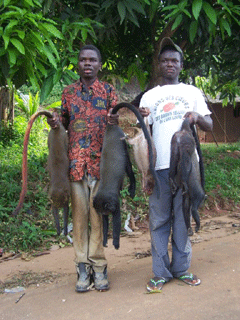
(Courtesy of UCLA School of Public Health/Dr. Nathan Wolfe)
GELLERMAN: It’s Living on Earth. I’m Bruce Gellerman. Many of the deadly infectious diseases that plague people - first infected animals. The Bubonic Plague came from infected rats the Spanish Flu pandemic came from birds and scientists have tracked HIV, the AIDS causing virus, to chimpanzees.
Still, researchers don't know precisely how viruses jump from one species to another or what triggers a viral disease to spread like wildfire. One of the scientists searching for answers is Nathan Wolfe. A biologist at UCLA, Dr. Wolfe calls himself a Virus Hunter. We hunted him down at his home in Venice, California, but much of the time you'll find him in some far-flung place trying to prevent the next pandemic by detecting viruses before they make the leap from animal to people.
Hi Dr. Wolfe.
WOLFE: Ah, Hello.
GELLERMAN: How are you?
WOLFE: I’m doing ok. I have a bit of a cold. Virus probably, one of the many viruses on the planet that we actually probably won’t ever identify.
GELLERMAN: Why not? I mean what would you do to identify this virus?
WOLFE: Well certainly one of the questions for us is, is a virus worth identifying? One of the really amazing things about being a biologist right around now is we have the tools to understand viruses and to identify them yet there are so many amazing things that are completely unknown. The world is absolutely filled with viruses so as we sort of start we have to kind of think about which ones are we going to bother to identify. And frankly my cold virus is not amongst them.
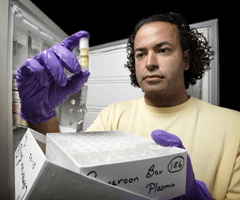
Dr. Nathan Wolfe (Courtesy of UCLA School of Public Health/Dr. Nathan Wolfe)
WOLFE: Oh, absolutely. Um, and of course one of the major objectives of my research is to try to identify what could lead to future pandemics. And instead of waiting for something like HIV to spread around the world in a way that’s going to be very very difficult to manage that we could actually try to understand these agents before they become major diseases. So if you kind of think of this process as a kind of process of a whole range of different viruses and other agents which are present in animals and then human beings, who we have our own diseases and we also have the potential to gain new diseases whether it be SARS or Ebola or HIV.
You know, you name it these are all things that are new, but the question is how do you catch that in the process? How do you actually watch one of these viruses jump from one species to the next species, and particularly from a species of animal into humans. And our idea is that we can actually try to catch this portal or bridge by focusing on people who have a lot of contact with animals. And that may be people who are working in markets where they sell live wild animals.
.gif)
Hunted Straw-coloured Fruit Bats (Eidolon helvum) are smoked and then sold for use in various dished in Southwest Province, Cameroon.(Courtesy of UCLA School of Public Health/Dr. Nathan Wolfe)
It may be individuals who are hunting or butchering wild animals. But whenever you have this sort of hunting and contact you’re going to have tremendous potential for transmition of agents in all different sorts of tissue. So we really think it’s a very important interface for the entry of new diseases into humans.
GELLERMAN: Well, how does that happen? How does a virus say start in a pig or a snake and then jump to a person?
WOLFE: Very honestly part of that is what we’re still studying and trying to determine but um often, you know, our vision in the states or the west of a hunter might be someone who’s decked out in army fatigues or wearing an orange vest but in most parts of the world where people are hunting for subsistence, you can, often hunters that we go out with will be wearing flip flops and a pair of shorts. They’ll be butchering with a machete.
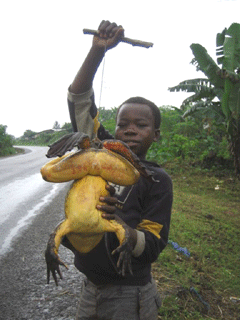
A boy selling a frog to be eaten. Conraua goliath, this species is known to be the largest frog in the world. It is only found in Cameroon and mainland Equatorial Guinea(Courtesy of UCLA School of Public Health/Dr. Nathan Wolfe)
GELLERMAN: You spent six years studying hunters in Cameroon. Um, what did you find?
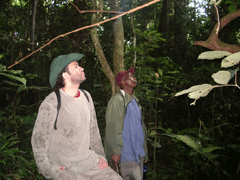
Dr. Wolfe in Cameroon (Courtesy of UCLA School of Public Health/Dr. Nathan Wolfe)
GELLERMAN: What was the name of the one that you found?
WOLFE: Well, we found a couple. Um, one of the viruses we found was pretty much unknown in humans other than in a few cases that were seen in people working in sort of laboratory situations but this is a virus called the simian foamy virus. And frankly it was quite a surprise I remember actually the moment in the laboratory when I was doing the tests and came across the definitive evidence that these viruses were, were in our hunters. And it really was an unusual and surprising discovery. I myself really didn’t expect to see it. I thought if it occurred it was quite rare but in fact we find that these viruses are probably in thousands, if not tens of thousands or more individuals who have close contact with, in this case particularly primates, monkeys and apes.

(Courtesy of UCLA School of Public Health/Dr. Nathan Wolfe)
WOLFE: Well, we don’t know about that yet. Retroviruses like HIV and HTLV which are the two really known important retroviruses in humans, they actually are chronic viruses. So unlike, for example Ebola, or flu or SARS, which make you sick and either you die or you get better, these are viruses which take a long time to make individuals sick. And for the foamy virus we’re actually out there right now working with these individuals who you know, generously contribute their time to participate in these studies to understand do these viruses spread? Do they cause disease? But we’re still really just at the beginning of the process of understanding what the importance of these agents is. But of course that’s the big idea. You discover it early and then you try to trace through what’s going on with the agent to see what’s happening with that.
.gif)
(Courtesy of UCLA School of Public Health/Dr. Nathan Wolfe)
WOLFE: Yes, absolutely.
GELLERMAN: So, how do you get them to trust you?
WOLFE: Well, we have long, I mean, we’ve been working in Cameroon now since 1998, 99. And what we have is we have long-term interactions in the villages we work in. For example through assistance with the US embassy in Cameroon and other sources we’ve been able to actually build in some of these communities health and conservation outreach centers. So we have a long-term interaction with these locations but I think it’s very important. You can imagine in any community that anybody’s living in somebody knocks on your door and starts saying, “oh, we’d like to talk to you about various activities and we’d like to sample your blood.” This is something which is a long-term process and to do it properly you really need to have a tremendous amount of buy in from the leadership within the village and from the individual hunters.
GELLERMAN: Is there some responsibility to them though, an ethical responsibility? Not just to follow them but perhaps treat them medically?
WOLFE: Oh, absolutely and we provide really a substantial amount of medical care for populations we work in. Now in the case of foamy virus we still haven’t determined if there’s a disease caused by foamy virus so there really isn’t any treatment to do. But um there’s a tremendous amount of counseling as to potential transmission. And ah, you know, so we spend a lot of time sort of dealing with people who are in these communities.
GELLERMAN: So, Nathan Wolfe how many potential pandemics are there waiting to happen?
WOLFE: Oh, well let’s just say there’ll be plenty of business for myself and people doing my line of work for many years to come. Things are changing. We’re becoming more urban increasingly. We have phenomenal globalization, which has all sorts of benefits but also has the fact that a virus that emerges somewhere in the middle of Central Africa today can be in Seattle, Washington tomorrow. So the level of connection between us and the animals around us and the sorts of populations and transport which allows these things to become established is changing very quickly. There do seem to be patterns about where these diseases come from. And so that just in the same way that we need to push forward the forecasting of weather, we try to understand what are the patterns of earthquakes and hurricanes. Just like that disease pandemics are a form of natural disaster and there’s no reason at all why we shouldn’t be moving these things forward and at least attempting to come up with predictive systems and forecasting systems. In a hundred years when people look back at this period of history they’re going to be saying, “Wow they really cared about these diseases. They really were trying to control them but they might have really been missing the boat they really waited for these things to become major pandemics. They didn’t try to understand the nature of them and try to control them early on before that happened.”
GELLERMAN: Well, Dr. Wolfe it was good speaking to you.
WOLFE: It was really nice speaking to you. Thank you very much.
GELLERMAN: UCLA biologist and virus hunter Nathan Wolfe is the lead author of the article "Origins of the Major Human Infectious Diseases." It’s in the current issue of Nature magazine.
[MUSIC: “The Fifth Plague” from ‘Plague Songs’ (4AD – 2006)]
Related link:
Nathan Wolfe's lab
Loss Lingers In New Orleans
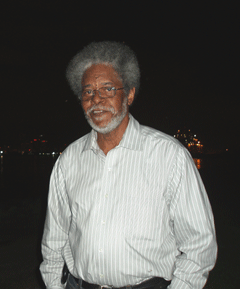
Rodney Dejoie (Courtesy of Ingrid Lobet)
GELLERMAN: Since the devastating hurricanes and floods that struck New Orleans almost two years ago life in the Big Easy has been anything but. As part of our continuing coverage of the Gulf Coast after Hurricanes Katrina and Rita, we take you this week to the holy cross neighborhood in New Orleans Ninth Ward home to Rodney Dejoie. He and his family have lived in the city for generations. His house is on a street that dead-ends into the rise of a levee holding back the Mississippi River.
Dejoie was a financial analyst for the city and before the storm, his neighbors knew him as a guy who took extra care to keep his neighborhood neat. But now the neighborhood is pretty much gone. Across from his property is a school where people used to park their cars. That’s where Living on Earth’s Ingrid Lobet met Rodney Dejoie one recent spring evening.
[MUSIC Miles Davis “Generique” from ‘Ascenseur Pour L’Echafaud’ (UMG Recordings – 1957)]
DEJOIE: This is the trailer I’m in. I’m about sick and tired of the trailer. I am housed in the trailer with my wife and my chow-chow dog, a full breed chow-chow that has become my shadow. I can’t move without him. He wants to follow me everywhere, and I have to step over him every time in the trailer, or bump into my wife. It’s really an obstacle course living in a trailer.
The trailers sweat, and near the windows there’s algae and mold growing. The carpets, they are damp all the time. You can leave the windows open when you’re not home to help with that, but on rainy days you have to close the windows. So you come home and it smells all musty and everything.

Rodney Dejoie (Courtesy of Ingrid Lobet)
Pre-Katrina this was sort of a lover’s lane or something in the evening. So you’d get people they came and frequent this area and they would discard stuff out in these parking spots and often times it was items that you didn’t want to touch with your hands.
People all the time ask me: Who do you work for? And my response is, I work for you. I work for me. I mean, this is for us so that we can enjoy a respectable lifestyle and we don’t’ have to live in filth and clutter, and that’s why I do it.
After Katrina it started out with just my neighbor and I in the area then we got another neighbor on the side street and now we have a fourth. But there’s nobody for five blocks on this street. It’s really mind-boggling really but I can’t blame anyone if they found better living conditions.
I mean this was the Big Easy at one time, that was one of our monikers, but now it’s a Big Struggle, it’s really hard living here.
I had just completed a renovation of my home in 2000. I was really ready to, for the good life. I mean I’m involved in physical activity on the weekends. So, (coughs) I’d greatly like to get back to that, I haven’t been able to because I can’t even focus on social, social activities. I haven’t been able to enjoy Mardi Gras. I haven’t been able to enjoy the Jazzfest, and I mean, I am a diehard, I go to every day, all seven days of the Jazzfest, and I just don’t enjoy it anymore. I don’t see the same people at the Jazzfest. It was like a reunion every year. I’d see people from all over the country that I’d see every year. I didn’t even go to the parades this year to enjoy Mardi Gras. I mean I was so busy trying to piece back my life.
[MUSIC: Miles Davis “Take It Or Leave It” from ‘Miles Davis: The Complete Bitches Brew Sessions (Box Set)’ (Sony Music – 1970)]
Maybe I’m suffering form some sort of depression or something I don’t know, I haven’t been to a psychiatrist or any of that kind of stuff, I just go on to get back to normal.
Now, this is a great view here. This is the Mississippi River, um, you can see downtown New Orleans’ skyline. You can see the Crescent City Connection, the twin bridges there.
I really enjoy living back here, I’ve been back here since 1980. I never thought about living anywhere else. But fear of the unknown has me thinking along those lines.
[MUSIC: 2.) Miles Davis “Take It Or Leave It” from ‘Miles Davis: The Complete Bitches Brew Sessions (Box Set)’ (Sony Music – 1970)]
GELLERMAN: Our profile of Rodney Dejoie was produced by Living on Earth’s Ingrid Lobet.
Related links:
- Help Holy Cross (Holy Cross neighborhood in New Orleans)
- Common Ground Collective
- All Congregations Together
GELLERMAN: Next time on Living on Earth. She would have been 100 years old this month. We commemorate Rachel Carson author of Silent Spring.
CARSON: We spray our elms and the following springs are silent of robin song, not because we sprayed the robins directly but because the poison traveled step through the now familiar elm leaf, earthworm, robin cycle.
GELLERMAN: The life and legacy of Rachel Carson. On the next Living on Earth.
GELLERMAN: We leave you this week by striking up the band and trumpeting and clanging and thumping.
[THAI ELEPHANT ORCHESTRA: “Three Baht Opera” recorded by David Soldier & Richard Lair at the Thai Elephant Conservation Center in Lampang Province, Thailand from “Elephonic Rhapsodies” (Mulatta Records – 2004)]
GELLERMAN: This clanging and thumping and trumpeting is performed by the Thai Elephant Orchestra. The pachyderms have been trained to create their own music using tools confiscated from illegal loggers. David Soldier and Richard Lair recorded this piece that the elephants’ trainers call "Three Baht Opera" at the Thai Elephant Conservation Center in Lampang Province, Thailand.
GELLERMAN: Living on Earth’s clanging, thumping, and trumpeting is produced by the World Media Foundation. Our crew includes Ashley Ahearn, Eileen Bolinsky, Ian Gray, Ingrid Lobet, Jennifer Percy, Emily Taylor, Peter Thomson and Jeff Young - with help from Bobby Bascomb, and Kelley Cronin. Our interns are Paige Doughty and Meghan Vigeant. Dennis Foley is our technical director. Alison Lirish Dean composed our themes. Our Executive Producer is Steve Curwood. You can find us at LOE dot org. I’m Bruce Gellerman.Thanks for playing along.
ANNOUNCER: Funding for Living on Earth comes from the National Science Foundation, supporting coverage of emerging science; and Stonyfield farm, organic yogurt and smoothies. Stonyfield pays its farmers not to use artificial growth hormones on their cows. Details at Stonyfield dot com. Support also comes from you, our listeners, the Ford Foundation, the Geraldine R. Dodge Foundation, and the Saunders Hotel Group of Boston’s Lenox and Copley Square Hotels. Serving you and the environment while helping preserve the past and protect the future. 800 2-2-5 7-6-7-6
Living on Earth wants to hear from you!
Living on Earth
62 Calef Highway, Suite 212
Lee, NH 03861
Telephone: 617-287-4121
E-mail: comments@loe.org
Newsletter [Click here]
Donate to Living on Earth!
Living on Earth is an independent media program and relies entirely on contributions from listeners and institutions supporting public service. Please donate now to preserve an independent environmental voice.
NewsletterLiving on Earth offers a weekly delivery of the show's rundown to your mailbox. Sign up for our newsletter today!
 Sailors For The Sea: Be the change you want to sea.
Sailors For The Sea: Be the change you want to sea.
 The Grantham Foundation for the Protection of the Environment: Committed to protecting and improving the health of the global environment.
The Grantham Foundation for the Protection of the Environment: Committed to protecting and improving the health of the global environment.
 Contribute to Living on Earth and receive, as our gift to you, an archival print of one of Mark Seth Lender's extraordinary wildlife photographs. Follow the link to see Mark's current collection of photographs.
Contribute to Living on Earth and receive, as our gift to you, an archival print of one of Mark Seth Lender's extraordinary wildlife photographs. Follow the link to see Mark's current collection of photographs.
 Buy a signed copy of Mark Seth Lender's book Smeagull the Seagull & support Living on Earth
Buy a signed copy of Mark Seth Lender's book Smeagull the Seagull & support Living on Earth

